Steering Through the Fog – Leaders Know This All Too Well. Decisions under uncertainty—we make them every day. As individuals, as leadership teams, as organizations. Artificial Intelligence (AI) can be a valuable sparring partner in decision-making processes. But how do we use it wisely while ensuring that, despite machines at the wheel, we remain responsible?
What Makes Decisions Challenging?
We always decide within a field of relevant possibilities: whoever decides, commits—and at the same time declares what shall not be. You could say: every decision is a betrayal of the alternatives.
And: No decision exists in isolation—it sends ripples. This is just as true personally as it is strategically. Leadership means consciously excluding alternatives—with all consequences. The greater the role, the farther-reaching the impact.
How Do We Make Good Decisions—and Where Do Pitfalls Lurk?
Good decisions require clear evaluation criteria, multiple perspectives, and a timeframe to assess consequences. What seems good in the short term can be harmful in the long term—and vice versa. It becomes even more complex when different stakeholders are involved (e.g., shareholders, employees, society). Without clear goals, conscious reflection, and a systematic approach, decisions fall prey to emotions, time pressure, groupthink—or individual egos.
Recommendations for Action: How AI Supports Decision-Making
How can AI support me?
The bad news upfront—and actually, it’s good news: AI cannot decide for you. But it can be a valuable sparring partner on the path to a decision:
- Preparatory Analysis: AI scans data sources, identifies patterns and relevant factors—including possible evaluation criteria and their relevance over time.
- Sharpening the Evaluation Grid: It reminds us of important criteria (ethical, regulatory, strategic, etc.) and broadens the view of potential consequences.
- Fostering Self-Reflection: AI can ask, “Have you considered the consequences?” or point out necessary decision steps—supporting the tracking of one’s decision logic and reflection on possible biases.
What Are Practical Tips for Decision-Making with AI?
Decisions can be improved with AI. But this requires using it safely. What should be considered?
- Define a clear question – What exactly do I want to know?
- Check data quality – Is it relevant, up to date, representative?
- Critically question AI results – Why does AI suggest certain evaluation criteria?
- Use AI as a sparring partner – Let it challenge your decision logic critically.
- Plan a reflection step – Let it pose reflection questions.
What Remains Human in the End?
Decisions are expressions of responsibility, values, and attitude. AI has no perspective, no standpoint. It is only statistics.
Whether you like it or not—what remains yours is:
- Responsibility: Humans bear legal, moral, and strategic responsibility for their decisions.
- Values & Ethics: AI “knows” ethics and morals—but it does not have them. It only has training that forbids certain things.
- Empathy & Context Awareness: Only humans understand subtle social dynamics and the context in which decisions are made.
- Intuition: Human intuition complements rational analysis—especially in VUCA situations, this is a real advantage.
Conclusion: AI Strengthens Us When We Lead
AI does not make us redundant—it refines our decisions. But this requires the following Dos & Don’ts:
“Only those who decide, exist” – this sentence by Martin Luther gains new meaning today. Those who use AI in decision-making processes and thereby consciously strengthen their own skills build both: competence and relevance. AI can set the stage—but we are the ones who perform the play.
Music tip from our AI for this article 😉🤖:
You are currently viewing a placeholder content from Spotify. To access the actual content, click the button below. Please note that doing so will share data with third-party providers.

